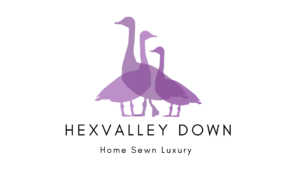© Copyright – Hex Valley Down | Website Developed by Tiny Giant Studios
What is down and where does it come from?
Down is the soft and fluffy under-plumage of waterfowl such as geese, ducks and swans, protected by the outer layer of feathers which insulates the bird against the cold. One unit of down is known as a cluster and each cluster has a three dimensional structure which is comprised of a barely visible core, the quill point (with no quill shaft) and thousands of soft filaments which radiate from it. Down clusters have the same physical appearance as the dandelion pods. Due to its structure, it has the ability to loft (to fill the space it occupies) and attach to the surrounding clusters to form a network which traps the warm heat (referred to as ‘air pockets’) generated by the body while still allowing moisture to escape.
What are feathers?
Feathers are the main covering of birds that grow from its skin with a two dimensional structure: the horny hollow stem (tubular quill shaft) and the fine strands on both sides. It is much heavier than down clusters and also not as resilient.
Why is goose down the superior insulators?
The bigger the cluster, the more effectively warm air pockets are trapped as the fluffy filaments of the down clusters interlock and overlap – thus keeping the heat in and the cold out. Therefore, the larger and more mature the bird, the larger the cluster is. This in turn ensures larger warm air pockets, which provide better insulation of heat. All of these factors result in a higher quality product.
For this reason geese provide higher quality down plumes which are stronger, more durable and have more filling power. Small down clusters from smaller birds such as ducks, are constructed with more fragile filaments which do not have the same filling power as the bigger clusters and tend to collapse after a certain period of use.
What is filling power?
This refers to the ability of the down cluster to regain its original fluffy volume after compression due to storage or use. It also indicates the ability to retain warmth generated by the body.
Where does the Hex Valley down and feathers come from?
Most importantly, our birds are free range and mature geese and under no circumstances to we kill or mistreat our birds for their down and feathers. We gather our top quality, large cluster, hand-harvested down and feathers from our geese when the down clusters have reached their full size, therefore ensuring the full potential to effectively insulate the body.
We do not use processed filling or mix qualities for any of our products but pure goose down and feathers only.
White vs. grey/black down and feathers - does it make a difference in quality?
It is important to note that the quality of the filling is not in any way affected by the color of the down and feathers, but rather determined by the size and maturity of the goose.
I have bad allergy and asthma problems; surely I would not be able to use your products?
Through our unique cleaning process, we ensure that our down and feathers are cleansed thoroughly with great precision. We wash, remove dust and dirt, sterilize and treat our filling with an SABS approved, very successful, anti-allergic rinse to provide you with clean, comfortable and allergy-free luxury. The result is a range of products which can be used and enjoyed by everybody.
What is the difference between pure down, processed filling and synthetics?
Most importantly: Quality. The statement: one get what one pays for – most certainly goes both ways. Due to the remarkable attributes of pure goose down, it ensures unrivaled sleeping comfort to ensure a good night’s rest. A standard which neither synthetics nor processed down will be able to measure up to.
Longevity
In comparison to the plentiful feathers available, down is scarce and therefore priced higher. When feathers are processed to produce artificial down (known as Q16), the quill shaft is damaged or chopped to copy the softness of the down cluster. Over a period of time this damaged feather will disintegrate and lose the initial insulating power, creating lumps and cold spots. It may have a lifespan of between 2 to 5 years.
However, when correctly taken care of, down can have a lifespan of up to a 100+ years, an investment and inheritance for generations to come. We have rejuvenated quilts of 90 and even over a 100 years where the quality of the filling has stood the test of time and it was only necessary to replace the outer cover at a small cost.
Comfort
While synthetics remain rigid, down covers you comfortably and snugly. As less down is needed to create insulation, the duvet does not weigh heavily upon you. In comparison, synthetics and processed down, though cheaper and not as scarce, mat and lump together creating empty- and cold spots, providing insufficient warmth and cannot ensure the essential good nights’ rest, comfort and luxury.
Resilient
When down is scrunched up, compressed or flattened due to use, storage or shipping, the quality and structure of the down clusters aren’t damaged and can be restored to its original volume by a good and thorough shake. It doesn’t lose its ability to insulate and retain warmth.
Breathable
Down has the ability to trap heat generated by your body (referred to as ‘air pockets’) and still allow moisture to escape thus preventing perspiration and the feeling of clamminess which you often experience with synthetics.
Should you have any other questions or comments regarding our products, please feel free to contact us or submit a question below. We would love to hear from you as your input is of the utmost importance to us to monitor the performance of our products and services to you.
How to promote longevity
Here are a few tips on how to prolong the longevity of our products:
- Pillows should be fluffed every day. Pillow fill is compressed each night as you sleep, which will eventually result in a thin and ineffective pillow.
- Airing and fluffing your duvet often is necessary. This will loosen any compressed down. Refrain from laying on top of your duvet as though this causes no damage to the filling, it does compress it to a thin and very ineffective layer.
- Never send these to the dry cleaners for cleansing, the chemicals they use damage the fibres. If cleaning proves to be a challenge to you, we will assist at a small fee.
- Always use pillow protectors underneath the standard pillowcase as it effectively absorbs any moisture, oiliness and spills, and prevent discolouring of the inner casing.
- When storing products away for a season, always use a breathable storage bag (also available for purchase). Duvets can be folded up loosely and stuffed inside the storage bag. Never use plastic bags or carton boxes as these will decrease breathability of your product.
- Sleeping bags should be stored away loosely and rolled up in a breathable storage bag or hung upside down, inside out, in a dry area. Never store your bag away cramped into the tiny space of a stuff sack.
- Feather beds need to be shaken now and then as you remove linen for washing.
- Refrain from lying directly on top of the feather bed. Always use a feather bed protector or fitted sheet.
How to wash your products
This may be a tedious task which when needed, we can gladly assist. When we clean your used pillow, we remove the fill to wash separately and then refill a brand-new casing. However, if you’re up for cleaning it yourself, then choose a hot and dry day and start early as you’ll need enough time for washing and proper drying especially if you do not have a tumble drier. Please note to never have any Hex Valley Down products cleaned by dry cleaners as their detergents could contain chemicals harmful to your filling.
- Firstly, check your product for any tears, otherwise you’ll end up losing a lot of filling during the washing process.
- Treat any spots or stains with Vanish stain remover. (waste vanish)
- Wash your duvets, sleeping bags and pillows separately in a washing machine.
- Use only Woollite or Golden Product’s Super 10 as detergent, do not add ordinary detergent or fabric softeners which could ruin the down- and feathers’ natural properties.
- Only wash on a cold and gently cycle, give it an additional rinse and then use the spinning cycle to drain excess moisture.
- Dry your products in a tumble drier on low heat until it is completely dry, shaking it every 15 minutes to loosen any lumps. Adding 2 or 3 tennis balls will help fluff and spread the down.
- Please make sure your product is completely dry before using it again. Any moisture might cause unpleasant smells and lumps.

